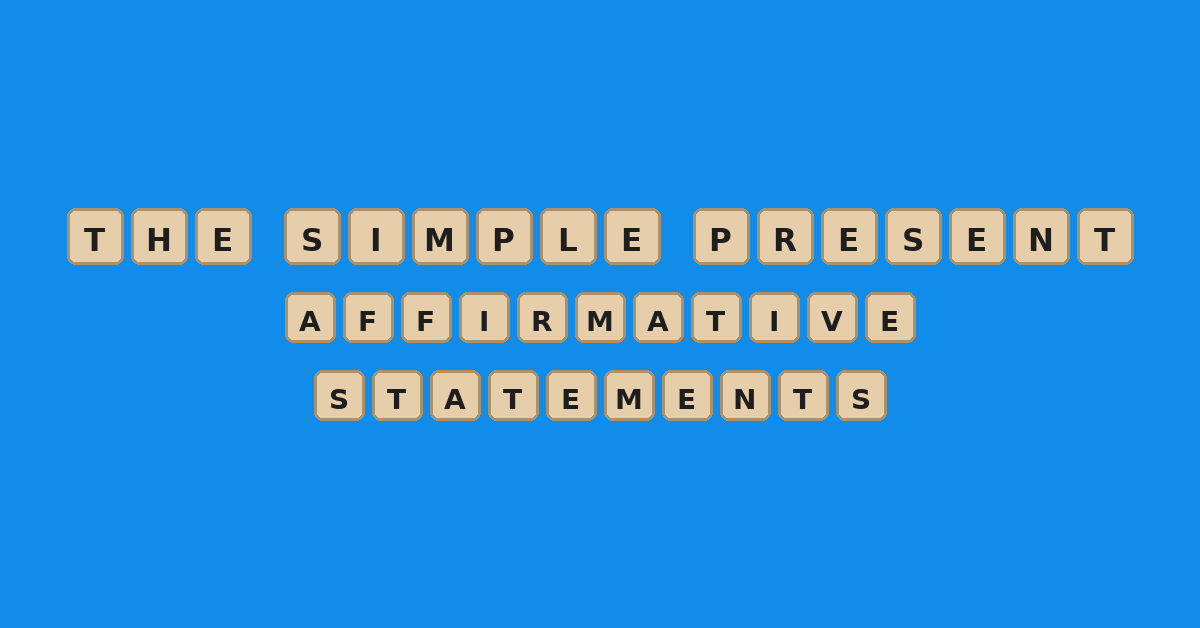The simple present tense is one of the first things ESL students learn – and for good reason! We use it to talk about everyday life: your habits, routines, facts, and things that never change. For example: The sun rises in the east (always true), I brush my teeth every morning (hopefully true), and My cat sleeps all day (definitely true). The Simple Present might look “simple,” but it’s everywhere in English. Mastering it will help you sound more natural in daily conversations.
✅ Affirmative Statements
The Simple Present tense often starts with the basics: affirmative (positive) sentences. These are the sentences that tell us something is true, simple, and clear. For example: I like pizza. She plays soccer. The Earth is round. Easy, right? Affirmative sentences are the building blocks of English communication—without them, we couldn’t share even the simplest facts about our lives.
✨ Every sentence you make is a step toward telling your story in English.
Affirmative Sentences in the Simple Present Tense: Rules and Examples
Subject-Verb Agreement
There are two forms for affirmative statements in the simple present.
1. For the following subjects we use the base form of the verb:
I
You
We
They
Plural Nouns
Remember!
Plural = 2 or more
✅ Examples
- I play soccer.
- You like pizza.
- We study English on Mondays.
- They live in San Antonio.
- Dogs bark at cats.
2. For the following subjects we use the -s form of the verb:
He
She
It
Singular Nouns
Remember!
Singular = 1
✅ Examples
- He plays soccer.
- She likes pizza.
- It rains a lot in April.
- The teacher speaks really fast!
Spelling Guide: Adding -s in the Simple Present
1. Most verbs → Add –s to the end of the verb
- work → works
- play → plays
- read → reads
2. Verbs ending in –s, –ch, –x, or –o → Add –es to the end of the verb
- pass → passes
- wash → washes
- watch → watches
- fix → fixes
- go → goes
3. Verbs ending in consonant + y → Change y to i + add –es
- study → studies
- carry → carries
- try → tries
⚠️ But if the verb ends in a vowel + y, just add -s.
- play → plays
- enjoy → enjoys
4. Be careful with irregular forms
Some verbs are irregular (special). The most common one is:
- have → has
Common Verbs in the Simple Present
Here are some verbs you will see often:
- work
- study
- eat
- play
- live
- like
- have
Don’t forget the –s with he, she, it, and singular nouns!
✅ He drives to the gym.
❌ He drive to the gym.
✅ She works at a school.
❌ She work at a school.
✅ It plays at the park.
❌ It play at the park.
✅ The cat sleeps on the couch.
❌ The cat sleep on the couch.
Let’s Practice!
A. Choose the correct option for each sentence.
1. I ___ to school every day.
a) go
b) goes
2. She ___ English on Monday.
a) study
b) studies
3. They ___ in a big house.
a) live
b) lives
4. He ___ pizza on Fridays.
a) eat
b) eats
5. We ___ the guitar.
a) play
b) plays
B. Write the correct form of the verb in (parentheses).
1. He ___ (study) English every day. → He studies English every day.
2. She ___ (wash) the dishes. → She washes the dishes.
3. It ___ (rain) a lot in May. → It rains a lot in May.
4. They ___ (work) at the coffee shop.
5. Lucia ___ (have) two dogs and one cat.
Scoring & Feedback
🔵 8 – 10 Correct
Excellent work! 🎉 You are ready to use the simple present in affirmative statements in your daily life. Keep using them in your everyday conversations and writing.
🟢 6 – 7 Correct
Good effort! ✅ You are on the right track. Review the ones you missed and keep practicing.
🔴0 – 5 Correct
No Worries! 🌱 You’re learning, and that’s what matters. Take a moment to review the examples and do the quiz again.
Want more reading, writing, listening, and speaking practice? Check out the Essential English series on Amazon!
Conclusion
Use the simple present every day when you talk about your life. Practice making affirmative statements about yourself, your family, and your routine. The more you practice, the easier it becomes! Subscribe for updated content from Beyond English!
Leave a comment below!

